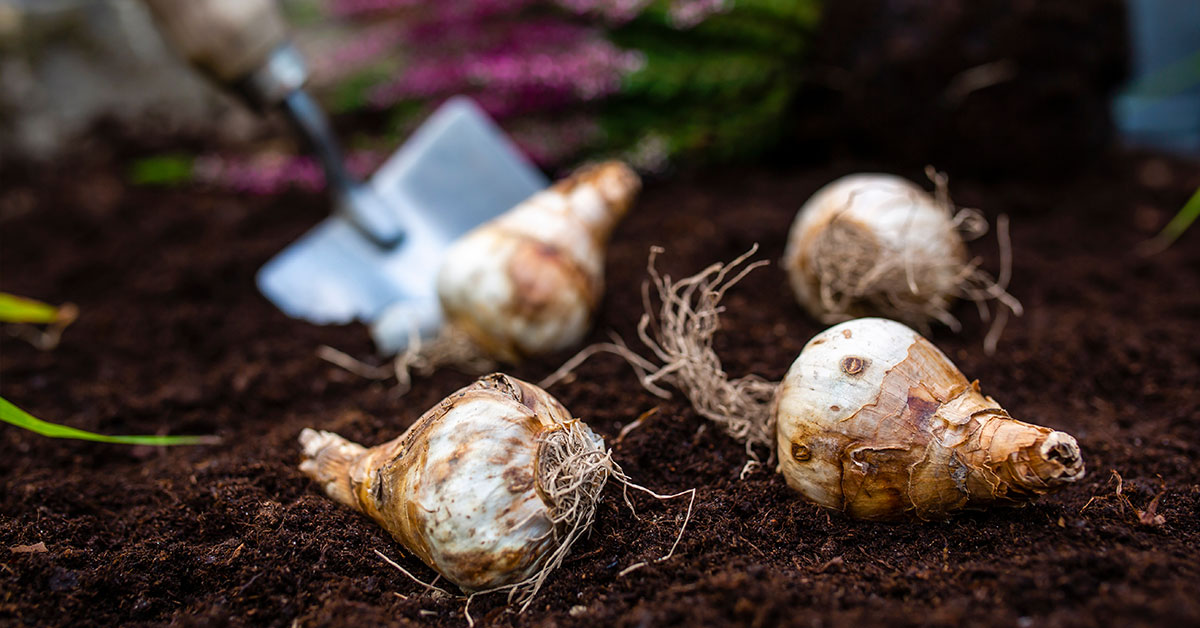Growing daffodil bulbs in Zone 7, which has a somewhat mild climate with cool winters, can be quite easy with proper care and the selection of hardy varieties. Daffodils are known for their cold tolerance and tend to do best in zones 3-9. Many cultivars will easily thrive in Zone 7’s climate. In this article, we’ll explore the best time to plant daffodil bulbs and how to do it.
Popular daffodil varieties
Daffodils are cherished for their cheerful blooms that signal the arrival of spring. With numerous varieties available, gardeners can choose from a wide range of colors, shapes, and sizes. Because of this, daffodils remain a popular choice for gardeners seeking to add a touch of springtime cheer. These are some popular varieties of daffodils to consider growing in Zone 7:
- ‘Dutch Master’ (Trumpet daffodil): Yellow flowers with a large trumpet
- ‘Mount Hood’ (Trumpet daffodil): Pure white flowers with a large trumpet
- ‘Golden Harvest’ (Trumpet daffodil): Golden yellow flowers with a long trumpet
- ‘Carlton’ (Large-cupped daffodil): Yellow flowers with a slightly darker, large cup
- ‘Ice Follies’ (Large-cupped daffodil): White petals with a pale yellow cup that fades to white
- ‘Pink Charm’ (Large-cupped daffodil): White petals with a contrasting pinkish-orange cup
- ‘Barrett Browning’ (Small-cupped daffodil): White petals with a bright orange cup
- ‘Tahiti’ (Double daffodil): Golden yellow petals with vibrant orange accents, creating a ruffled appearance
- ‘Thalia’ (Triandrus daffodil): Pure white, fragrant flowers with a slightly nodding habit
- ‘Jetfire’ (Cyclamineus daffodil): Bright yellow petals with an orange-red trumpet, and petals swept back from the trumpet
Choosing the right color daffodils for your garden can enhance the overall aesthetic and create a harmonious, visually pleasing environment. Consider the existing color palette of your garden, including other flowering plants, foliage, and hardscape elements. By selecting daffodil varieties that complement or contrast with these colors, you can create stunning focal points.
Additional Resource: What Do Daffodils Symbolize?
When to plant daffodil bulbs in Zone 7
Planting daffodil bulbs at the right time is crucial for achieving beautiful blooms in the spring. Ideally, you should plant your daffodil bulbs about 4 weeks before the first frost in the fall. This timing allows the bulbs to establish a strong root system before the ground freezes and ensures they are ready to grow and bloom once warmer temperatures return.
In Zone 7, your first frost date is around October 29th, so you should try to get your daffodil bulbs in the ground around September 29th. If you’ve missed your window of opportunity, don’t worry, you can store your daffodil bulbs for next year.
Planting daffodil bulbs in the spring is not recommended. These flowers require a period of cold dormancy to stimulate root development and prepare for blooming. Daffodils planted in the spring are unlikely to have enough time to establish a strong root system. This may result in weak or stunted growth, and potentially no blooms at all.
By planting daffodil bulbs in the fall, you allow them to develop roots and go through the necessary chilling period. Proper timing ensures a healthy, vibrant display of flowers and allows the bulbs to store enough energy for the following year’s growth.
Additional Resource: When Should I Expect My Daffodils To Bloom?
How to plant daffodil bulbs in Zone 7
A key part of successfully growing daffodils in location isn’t just knowing when to plant them. You should know how to plant them as well. Improperly planted daffodils are a lot less likely to grow, flower, and thrive. Here’s our step-by-step guide for planting daffodil bulbs in Zone 7:
- Choose the right time: Plant daffodil bulbs in the fall, approximately 4 weeks before the first expected frost in your area. This will give the bulbs enough time to establish roots before the ground freezes.
- Select a suitable location: Choose a well-draining area that receives at least 6 hours of sunlight per day. Daffodils prefer full sun to partial shade.
- Prepare the soil: Loosen the soil to a depth of 12-14 inches and amend it with compost or well-rotted organic matter to improve drainage and fertility. If your soil is heavy clay, consider adding sand or grit to help with drainage.
- Plan your layout: Arrange the daffodil bulbs in your desired pattern, considering color, height, and bloom time for a visually appealing display. Space the bulbs approximately 4-6 inches apart.
- Dig holes: Create holes for the bulbs that are about 3 times the height of the bulb. For most daffodil bulbs, this means a hole that is 6-8 inches deep.
- Place the bulbs: Position the bulbs with the pointed end facing up, as this is where the stem will emerge. Place each bulb in its respective hole.
- Cover the bulbs: Fill the holes with soil, gently pressing down to remove any air pockets. Water the area thoroughly to settle the soil and encourage root growth.
- Mulch (optional): Apply a 2-3 inch layer of mulch, such as shredded bark or compost, to help retain moisture and provide insulation against temperature fluctuations.
- Mark the location: Label the planting area with plant markers or stakes to remember where you planted the bulbs and avoid accidentally digging them up in the future.
Allow the bulbs to establish roots during the winter months. As the weather warms up, watch for the first signs of growth, and soon enough, you’ll be rewarded with a beautiful display of daffodil blooms.
Additional Resource: How To Divide And Transplant Daffodils













